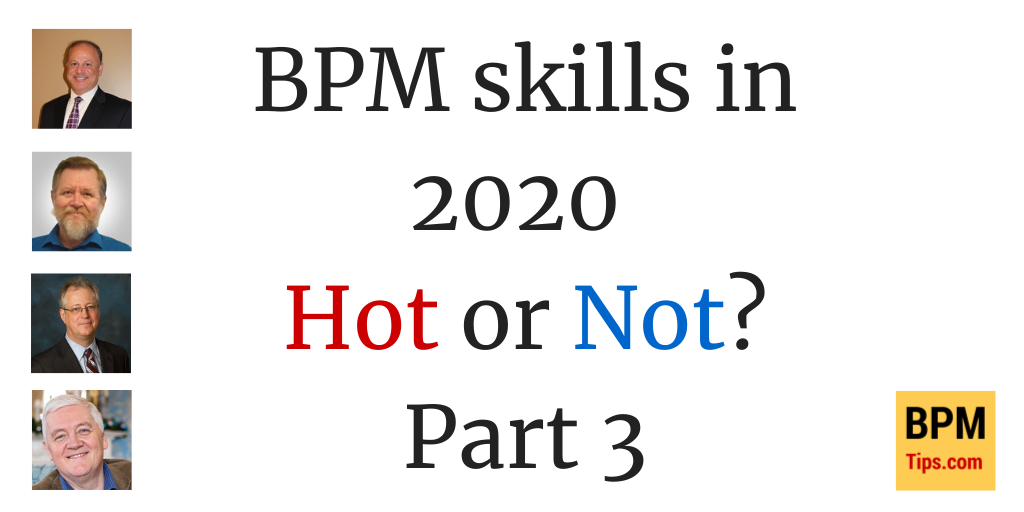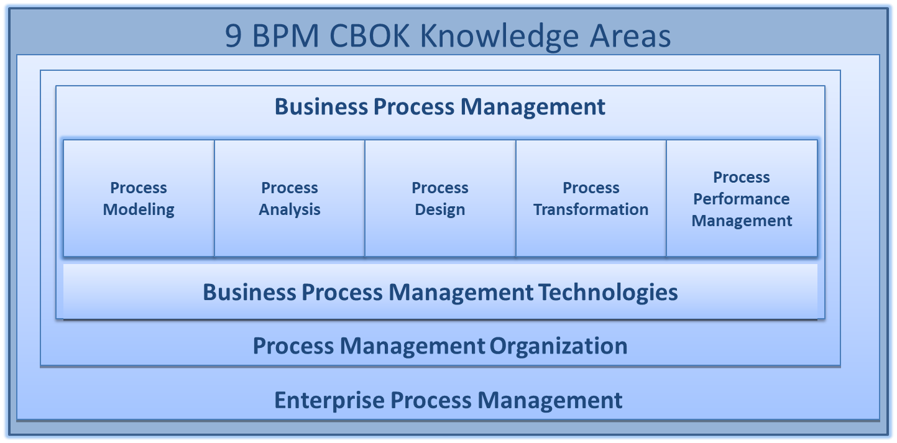Do you want to learn more about BPM skills in 2020? Part 3 of the post is waiting for you!
Below you can see answers to the questions regarding BPM skills in 2020 from the following experts:
Tony Benedict
Pierre Col
Keith Swenson
Steve Towers

Tony Benedict
 Tony Benedict is a Partner with Omicron Partners, LLC, a strategy advisory firm. He is a senior level operations executive best known for transforming organizations, improving operational excellence and profitability. Most recently, he worked at HonorHealth as Vice President, Procurement and Supply Chain where he was responsible for over $600M in spend management. One of his accomplishments was in the restructuring of the procurement and supply chain organizations post-merger within 12 months and consolidating two ERP systems within 18 months while implementing $31M in cost reduction initiatives. Previously, he was Chief Information Officer, Vice President of Supply Chain for Tenet, and Vice President, Supply Chain, Vanguard Health Systems at Abrazo Community Health Network in Arizona.
Tony Benedict is a Partner with Omicron Partners, LLC, a strategy advisory firm. He is a senior level operations executive best known for transforming organizations, improving operational excellence and profitability. Most recently, he worked at HonorHealth as Vice President, Procurement and Supply Chain where he was responsible for over $600M in spend management. One of his accomplishments was in the restructuring of the procurement and supply chain organizations post-merger within 12 months and consolidating two ERP systems within 18 months while implementing $31M in cost reduction initiatives. Previously, he was Chief Information Officer, Vice President of Supply Chain for Tenet, and Vice President, Supply Chain, Vanguard Health Systems at Abrazo Community Health Network in Arizona.
He is currently serving as President and Director, Board of Directors for the Association of Business Process Management Professionals International and is a co-author of the Business Process Management Common Body of Knowledge versions 2, 3 and the recently released version 4.
WWW: http://www.abpmp.org
WWW: LI profile
What are the skills, techniques, behaviors, and attitudes that can help BPM practitioners create value for their organizations in 2020?
It would be the full spectrum of BPM knowledge areas, skills and competencies that go beyond just modeling and automating business processes. Automation is just one form of process improvement but it’s not the only avenue to improvements or business/digital transformations. I don’t recall where this came from, however, the concept is that the degree of one’s proficiency in any area of expertise has been shown to come from a mix of mentoring, training/education and experience with relative percentages at 10%, 20% and 70% respectively. This idea presumes that there is a set of foundational knowledge, skills and competencies in any profession that one must come to understand before one can gain proficiency from experience.
After 20 plus years, there should be no argument that good BPM practices create value for customers and organizations. ABPMP (Association of Business Process Management Professionals) decided to establish what the BPM the foundational knowledge, skills and competencies (KSCs) should be and that understanding led us to approach BPM practitioner roles as a continuum of learning and development comprised of set of KSCs and the experience that is acquired over the course of one’s career. The knowledge areas are addressed in our BPM CBOK (Common Body of Knowledge, more information here: https://www.abpmp.org/page/guide_BPM_CBOK) and are noted in the following graphic:
The skills and competencies are outlined in detail in our BPM Competency Model (available for free here: https://www.abpmp.org/page/CompetencyModel). All of the KSCs are embodied in a BPM Life Cycle model for constant renewal in the management of business processes for creating value for customers. The BPM Life Cycle Model is shown in the following graphic:
The experience component is acquired through “on-the-job training,” emphasizing that one has to routinely be doing the continuum of the work outlined in the BPM CBOK and BPM Competency Model over the required years to meet certain experience levels as a BPM practitioner: Technician (< 4yrs), Manager (=4<10yrs) and Leadership (->10yrs) levels. ABPMP has developed three levels of BPM Certification to test each level. This is shown in the following one-page summary graphic:
The BPM Foundation is multidisciplinary and as a practitioner moves up the career ladder in any organization, they are expected to lead people and manage change, especially at executive levels. Experienced BPM practitioners know how to lead cross functionally because they understand the horizontal nature of business processes and managed through years of experience, know when to throttle the amount of organizational change in business or digital transformations. This BPM leadership experience is correlated to an organization’s ability to deliver value to customers. (See McKinsey article cited in next section).
What are the best resources to learn those skills? (e.g. books, articles, courses)
As mentioned earlier, the “one stop shop” for the commonly accepted BPM practices is the BPM CBOK (Common Body of Knowledge: https://www.abpmp.org/page/guide_BPM_CBOK) with over 400 pages of commonly accepted practices and our BPM Competency Model which is 13 pages of the detailed skills and competencies at each experience level (https://www.abpmp.org/page/CompetencyModel) which provides BPM Practitioners with the foundational level of knowledge, skills and competencies.
Most of the BPM books that are available assume that one has a baseline understanding of the “what” that comprises BPM. Many of the books tend to address approaches and methodologies on “how” to do BPM. There are some good books out there on methodologies (or techniques) that are usually written by independent consultants – it’s important to note that some of the differences in approach will be the scope of change: major cross functional processes versus functional (siloed) processes. The broader, cross functional scope is what you should look for in BPM books. There are also a few good books on mapping the customer journey, which is only a segment of BPM with respect to creating customer value through process. A suggestion is to read the Amazon reviews on any of these books and make sure the books have at least 80% favorable (4-5 stars) before making a buy decision. For BPM training, there is a small percentage of very thorough BPM training providers that will take you through a complete BPM Life Cycle during a 3-4-day workshop. There are also many niche players for process modeling/analysis/design using BPMN standards – with some of these providers using online learning systems.
There was a great article published by McKinsey last year titled: “The Business Value of Design.” Everyone should read it to understand the fundamental value in designing processes to deliver value and the leadership characteristics associated with process based cultures. There are many other published articles, white papers and webinars that tend to advocate the latest and greatest technologies for BPM. A word of caution – many of the technologies are immature and not widely adopted. Many of these articles (and /or webinars) are marketed by software companies pushing the next “big” thing. Before one follows trends and buzzwords, a simple question should be asked: “Is this technique, software, etc. commonly accepted by the BPM practitioner community such that the practices result in at least a 70% success rate?” If the answer is no, then it’s not quite ready for mass adoption. Another suggestion would be to read Gartner’s Hype Cycle for those technologies to give you an idea of where the technology is on that Hype Cycle. Most companies will start experimenting after the “trough of disillusionment” when all of the “bugs” are worked out and the licensing costs are more in line with the reality of implementations and ROI.
Which skills are no longer relevant or not practically applicable yet (hype)?
It’s probably not a question of what is no longer relevant or practically applicable, it’s more a question of what is used less because something better became available and the existing fell into specialized niches. For example, if you look at process modeling standards, UML and IDEF0 were very common and early modeling tools utilized that standard. Now, all popular modeling tools utilize BPMN 2.0 standards. With the advent of low code and no code software tools, the utilization of BPMN modeling tools might be relegated to those processes that will remain being performed by humans rather than systems or robots.
Pierre Col
 Head of Communications for Intelligent Robotic Process Automation, SAP
Head of Communications for Intelligent Robotic Process Automation, SAP
Pierre Col has an extensive 30+ years background & expertise in Marketing & Communications and Analyst & Investor Relations for Internet, Telecom & IT companies. Before the acquisition of Contextor by SAP in 2018, he was Chief Marketing Officer of the French-based RPA software vendor.
WWW: Company website
WWW: LI profile
I have to say that, coming from an RPA software vendor, I am a bit biased when it comes about automation. But after Contextor acquisition in November 2018, I am now working for more than one year at SAP, and that helped me broaden my views on process automation. Indeed, created in 1972 by five entrepreneurs who were aiming to automate enterprise processes, SAP is all about automation. and as I spent time last year with my colleagues from SAP Intelligent BPM team to integrate SAP Intelligent RPA in a coherent and comprehensive offer, I think that I can answer from an holistic Intelligent Automation standpoint.
What are the skills, techniques, behaviors, and attitudes that can help BPM practitioners create value for their organizations in 2020?
I believe that curiosity and mind openness are key. Many technologies appeared or spread during the last years such as RPA, AI with Machine Learning / Deep Learning, chatbots… Those tools are fully complementary to BPM, as they extend BPM capacity to further and better automate business processes with some agility. I would recommend BPM practitioners to understand those technologies in order to be able to leverage them when needed.
What are the best resources to learn those skills? (e.g. books, articles, courses)
Of course, you will find a lot of useful books and online resources to learn those skills, and I won’t repeat what others said before.
I would mention here some free MOOCs provided by SAP, to discover Intelligent RPA, to learn how to build your own RPA bots and to automate around S/4HANA ERP.
And as Artificial Intelligence is spreading everywhere, I consider that having explainable and ethical AI capabilities is very important for our future. That is why I also recommend that MOOC, “Creating Trustworthy and Ethical Artificial Intelligence”.
Which skills are no longer relevant or not practically applicable yet (hype)?
I can’t imagine a skill you acquired in the past becoming totally useless, or no longer relevant: it might be less applicable in some contexts, but the skills you have acquired are part of your experience, they shape the way you can consider business problems and imagine new solutions.
Of course, some skills or technologies can be over-hyped and not fully applicable yet in the day-to-day life of the average company. Nevertheless, it is important to keep an eye on it, in order to be able to use it when it starts making sense.
Keith Swenson
 Keith Swenson is Vice President of Research and Development at Fujitsu North America and also the Chairman of the Workflow Management Coalition. As a speaker, author, and contributor to many workflow and BPM standards, he is known for having been a pioneer in collaboration software and web services. He has led agile software development teams at MS2, Netscape, Ashton Tate & Fujitsu. He won the 2004 Marvin L. Manheim Award for outstanding contributions in the field of workflow. Co-author on more than 10 books. His latest book, “When Thinking Matters in the Workplace,” explains how to avoid stifling creativity and enhance innovation through the appropriate use of process technology. His 2010 book “Mastering the Unpredictable” introduced and defined the field of adaptive case management and established him as a Top Influencer in the field of case management. He blogs at https://social-biz.org/.
Keith Swenson is Vice President of Research and Development at Fujitsu North America and also the Chairman of the Workflow Management Coalition. As a speaker, author, and contributor to many workflow and BPM standards, he is known for having been a pioneer in collaboration software and web services. He has led agile software development teams at MS2, Netscape, Ashton Tate & Fujitsu. He won the 2004 Marvin L. Manheim Award for outstanding contributions in the field of workflow. Co-author on more than 10 books. His latest book, “When Thinking Matters in the Workplace,” explains how to avoid stifling creativity and enhance innovation through the appropriate use of process technology. His 2010 book “Mastering the Unpredictable” introduced and defined the field of adaptive case management and established him as a Top Influencer in the field of case management. He blogs at https://social-biz.org/.
WWW: https://social-biz.org
WWW: LI profile
Twitter: @swensonkeith
What are the skills, techniques, behaviors, and attitudes that can help BPM practitioners create value for their organizations in 2020?
What are the best resources to learn and master those skills? (e.g. books, articles, courses)
Which skills are no longer relevant or not practically applicable yet (hype)?
This has been particularly difficult for me to put together this year, because really many things have changed outside of the BPM field, that actually have profound, but as yet unrealized effects on the field.
When we look at BPM from 2003 – 2018 we see a focus on process modeling, and other kinds of modeling. Decision modeling is the latest in this trend. What is a process model? It is after all a depiction of what the people in the organization think the preferred way of handling a business problem is. This has always been negatively affected by the fact that much of this knowledge is tacit, and not consciously known by the workers. So interviews work to a limited extent, but the real process is more difficult to suss out. The next technique was one of Agile trial and continuous improvement: approximate the process as best you can, measure performance, and incrementally improve the process. But all of this is really traditional development: a programmer take the logic and codes it in a process model, in web services, or in glue code.
Today we are in the age of Alpha Go and learning software that is trained, and not programmed. These game-playing computers did well in extremely complex games like Go where the number of rules is small, but the possible combinations very high. The technique is likely to be even more useful when the exact rules are not known, like the rules of a business process. AI should watch the behaviors of the individuals, and be able to draw up rules of engagement of the business processes. Those rules may be completely opaque to the workers, managers, and programmers. That does not matter. What matters is that the rules work. Learning systems are likely to be able to route work to people far more efficiently than any externally applied process logic.
What this really means is that the traditional skill of modeling a process, and programming applications, is no longer relevant. Let me temper that: these will still be used to create BPM applications for another 10 years or so, but the demand for this will drop quickly. Instead, we will find that forward thinking organizations will deploy learning systems to watch the organization at work, to automatically identify processes that are stuck, and to proactively route them forward for completion. The process might be difference every single time, but that does not matter: the goal is efficiency of the organization, not regularity of the process.
I have attempted to explain all this in my book “Beyond the Business Process Model” where I outline not only the trend toward learning systems replacing bespoke BPM applications, but also outline the parameters that would be needed to make it all work. I must warn you: this idea has not been very well received in the industry, and there has really not been much uptake in readership of the book.
I think that process modeling and decision modeling are currently at their maturity. It will take a decade to swap out the current bespoke application approach, to a learning approach. The skills that you will need for that newer technology will be data science and deep learning. We are seeing this same trend in many areas that were traditionally implemented using standard programming techniques. We all need to learn new skills, and I can promise, it will be a fascinating ride.
Steve Towers
 Steve is the original Outside-In Pioneer, Amazon Best Seller, an Operations, BPM and Customer Experience Expert recently named Global Top 30 Guru, CEO BP Group and Loves the Mountains!
Steve is the original Outside-In Pioneer, Amazon Best Seller, an Operations, BPM and Customer Experience Expert recently named Global Top 30 Guru, CEO BP Group and Loves the Mountains!
BP Group was established 28 years ago to grow the professionalism of Business Process Management through upskilling, methods and technology associated with business processes and customer experience management. Since 2006 we have helped over 100,000 individuals qualify as Certified Process Professionals across 118 countries. In 2018 Steve become a startup investor in The Experience Manager, the worlds first customer experience employee engagement tool.
WWW: https://www.bpgroup.org
WWW: https://www.theexperiencemanager.com
Latest bestseller: Dare!
WWW: LI profile
Twitter: @stowers
What are the skills, techniques, behaviors, and attitudes that can help BPM practitioners create value for their organizations in 2020?
Are your skills growing beyond the technical and becoming aligned with customer success, or are you still playing the tune of times gone by?
The biggest challenge facing BPM professionals in this next decade will be enabling organizations to progressively embrace customer centricity. Without that capability long standing companies will wither and die as the digital tsunami sweeps away redundant business models. Sounds apocalyptic and in many ways it is.
A good basis for understanding the skills needed is provided by the transformation underway in the one of the world’s largest Utility companies. We have distilled six key factors in terms of evolving the process skillset as:
1. Integrating process into every aspect of the business
2. Engaging the organization around successful business and customer outcomes
3. Embracing new (and simplified) techniques to connect the dots across the enterprise
4. Evangelizing the reason process exists is to deliver successful customer outcomes
5. Encouraging everyone in the company to get ‘process’ and its fundamental contribution to their future careers and organizational success
6. Equipping the business for tomorrows unknown challenges and creating the attitude to see around corners, rather than looking in the rear-view mirror for answers to ‘where are we going next?’
We discuss in detail these attributes in greater detail in our new bestselling book Dare!
What are the best resources to learn those skills? (e.g. books, articles, courses)
The greatest learnings are nearly always evidential based complemented with innovation. What I mean by this is understanding and modeling the approaches adopted by global leading companies and especially when it comes to applying techniques that deliver immediate and sustained success. Only by consistently delivering business results will BPM remain relevant and accordingly the need is to demonstrate that this current project/program/initiative is moving the needle to deliver triple crown benefits – simultaneously lowering costs, improving service and growing revenues. Is your work doing this?
There are many theoretical books (still) being written on the theme of BPM however look for those more practical works that share case studies and real, hard as nails results. Understand how those people created success and seek to model their attitudes, behaviors and structures into your own work and that of colleagues.
Naturally I recommend the work of the BP Group where we continue to codify the success of leaders and companies and make them accessible for individuals and organizations upskilling themselves for long term success. The codification is now in version 12 of the CEMMethod™, accessible through our Certified Process Professional program.
Which skills are no longer relevant or not practically applicable yet (hype)?
Complex and syntax driven tools may have been the thing of yesterday however as the attention spans of customers and leadership teams has decreased to nano seconds that work takes too long. Immediate results become the validation to do more with BPM so keep it simple, direct and immediate.
Essentially industrial age mindsets are no longer relevant. We are not building factories and production lines we are enabling customers to achieve success in every experience they have with our organization. That shift to Outside-In thinking and practice is pervasive in high achieving companies we all recognize as delivering us as customers the best products and services. How many of these direct techniques and approaches have you embraced into your work recently?
PS. By popular demand 😉 (thanks Doug)
I thought you may also enjoy some more market overviews:
a) Broad one by Trend Watching: https://trendwatching.com/quarterly/2019-11/5-trends-2020/
b) Tech oriented by CB Insights (14 Tech Trends To Watch Closely In 2020): https://www.cbinsights.com/research/report/top-tech-trends-2020/
BTW: you may also enjoy their 2019 report “What’s Next In Enterprise IT” which mentions Workflow Automation: https://www.cbinsights.com/research/16-enterprise-it-trends-2019/
c) Last, but not least “Tech Trends 2020” by Deloitte: https://www2.deloitte.com/us/en/insights/focus/tech-trends.html



Great summaries and lists of resources. I’d also be interested in the outside in views about BPM and key relevancies from other disciplines (and their recognized leaders).
The principles of BPM are in reality very simple yet the joined up linking of tasks step by step and handle the complex. Are you aware that this is what the accounting profession were doing in the 1970s mapping out step by step salient processes to look for weaknesses for the focus of audit and inform management for future audits. It was very effective BUT then IT comes along with their “inside out” systems and frankly the accounting profession lost the plot! Great to read the views of all in particular Steve Towers.
In the 90s I came across -some new thinking in trying to sort out the mess which was emerging by the outside inside thinking and remove need to program code support for data creation by people. I knew nothing about “IT” and it seemed simple and logical so I got involved…wow 20+years on and only now are debates such as here being taken seriously. See our story on paper on web site below (or go to my twitter account) what we did and it works BUT very disruptive for existing supply chain…as I was warned after we found the answer. Enjoy and think of an interesting vision for the future support of operational business activity making BPM “hot”!